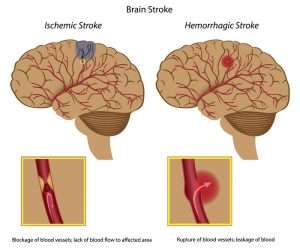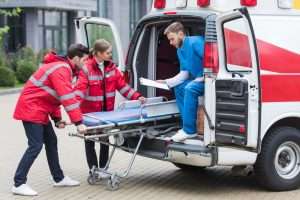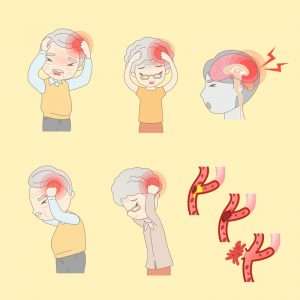Signs of a Stroke…
This blog is very important, it will explain what a stroke is and how you will know if you or someone else is having one. Knowing the signs and symptoms of a stroke can help you to save your own life or the life of someone you love!
It may even be someone you don’t know. Two-thirds of the people who call 9-1-1 about a potential stroke victim are actually bystanders to the event. That would bring you some especially good karma!
What really is a Stroke?
There are essentially two kinds of strokes. One is caused by a blocked artery to the brain and is called an ischemic stroke. This is a blood clot or a piece of plaque or other fatty deposit in your artery that has broken off. Ischemic strokes account for 87% of all strokes.
The second is a hemorrhagic stroke when a blood vessel bursts leaking blood into your brain. Even though only 13% of strokes are hemorrhagic it is usually more deadly, depending on where the burst blood vessel is located.
According to the American Heart Association’s “Heart Disease and Stroke Statistics – 2019 Update” there has been a rise in cardiovascular disease to 121.5 million adults in the U.S. (48%) which includes heart disease and stroke. In the U.S. in 2019 heart disease was the #1 cause of death, stroke was the #5 cause, and both places in the list were unchanged from 2018.
The uptick in the number of people with cardiovascular disease is partially attributed to the Blood Pressure category changes resulting in more people classified as having High Blood Pressure. (see my post about Blood Pressure)
The AHA also called out the “sharp increase” in adolescents using e-cigarettes and becoming addicted to tobacco at the same time that there had finally been a “consistent decline” in smoking in the older generations.
Prevention
80% of all strokes are preventable. Eat a healthy diet, stay physically active, and control the highest risk factors which are:
- smoking
- obesity
- diabetes
- high blood pressure
Having more than one of these risk factors is cited as one of the biggest reasons for why more people in their 30’s and 40’s are having strokes these days.
Signs of a Stroke
When you are having a stroke your brain is deprived of oxygen and your brain cells start dying immediately. It’s important that everyone be able to recognize when a stroke is happening as there are many different signs of a stroke and here are some of the most common ones:
- Face drooping – this is usually on just one side or area of the face
- Arm weakness – can’t raise your arm or you are dropping things with just one arm
- Speech difficulty – slurring or some other difficulty in talking
- Sudden numbness – the numbness can be anywhere in your body
- Sudden trouble seeing – can be in one or both eyes
- Sudden severe headache – can be anywhere in the head area
- Sudden trouble walking – can be related to balance, numbness, or dizziness
B.E. – F.A.S.T.
The medical and health community have created an acronym with the first letters of some of the symptoms above to help all of us recognize and come to the aid of anyone who might be having a stroke. The acronym is B.E. F.A.S.T. and it stands for:

B – Balance – Loss of or dizziness
E – Eyes – Blurred Vision
—
F – Face Drooping
A – Arm or Leg Weakness
S – Speech Difficulty
T – Time To Call 9-1-1
This is very important for all of us to learn and remember because in two-thirds of all cases it is a bystander who recognizes what’s going on and calls for help. And the faster someone gets medical help the better the chance that they will survive the stroke.
Calling 9-1-1 is also extremely important because ambulance and first responders are trained to handle and recognize these emergencies and they can sometimes start immediate treatment with medication. Don’t try to drive yourself or someone else to the hospital for the same reasons.
If you see someone having any of these symptoms call 9-1-1 immediately and don’t let them not go to the hospital. Time is very important when having a stroke and waiting to see if it gets worse before you or someone else gets help can make a big difference in their recovery or death.
You Can Save A Life
So remember the B E – F A S T acronym, remember the symptoms, and remember to get emergency help. The life you save may be your own or the life of a loved one. This is especially important as our parents, siblings, friends, and we ourselves get older!
